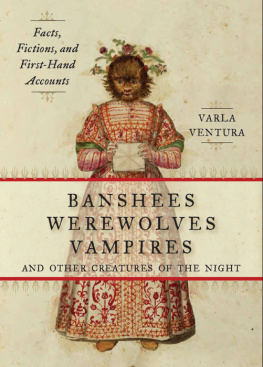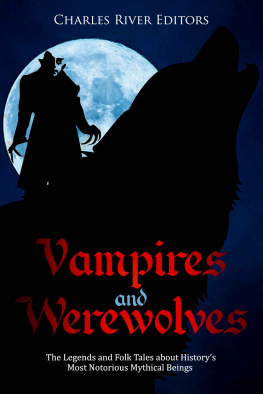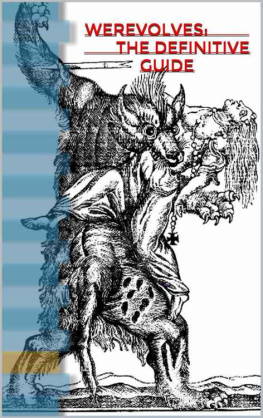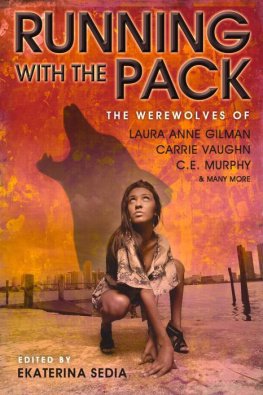Page List


CREATURES OF FANTASY
WEREWOLVES
BY
CYNTHIA A. ROBY
CAVENDISH SQUARE PUBLISHING NEW YORK
Published in 2016 by Cavendish Square Publishing, LLC
243 5th Avenue, Suite 136, New York, NY 10016
Copyright 2016 by Cavendish Square Publishing, LLC
First Edition
No part of this publication may be reproduced, stored in a retrieval system, or transmitted in any form or by any meanselectronic, mechanical, photocopying, recording, or otherwisewithout the prior permission of the copyright owner. Request for permission should be addressed to Permissions, Cavendish Square Publishing, 243 5th Avenue, Suite 136, New York, NY 10016. Tel (877) 980-4450; fax (877) 980-4454.
Website: cavendishsq.com
This publication represents the opinions and views of the author based on his or her personal experience, knowledge, and research. The information in this book serves as a general guide only. The author and publisher have used their best efforts in preparing this book and disclaim liability rising directly or indirectly from the use and application of this book.
CPSIA Compliance Information: Batch #WS15CSQ
All websites were available and accurate when this book was sent to press.
Library of Congress Cataloging-in-Publication Data
Roby, Cynthia A., author.
Werewolves / Cynthia A. Roby.
pages cm. (Creatures of fantasy)
Includes bibliographical references and index.
ISBN 978-1-50260-510-8 (hardcover) ISBN 978-1-50260-511-5 (ebook)
1. WerewolvesJuvenile literature. 2. WerewolvesFolkloreJuvenile literature. I. Title.
GR830.W4R63 2015
398.24'54dc23
2015006922
Editorial Director: David McNamara
Editor: Kristen Susienka
Copy Editor: Rebecca Rohan
Art Director: Jeffrey Talbot
Designer: Joseph Macri
Senior Production Manager: Jennifer Ryder-Talbot
Production Editor: Renni Johnson
Photo Research: J8 Media
The photographs in this book are used by permission and through the courtesy of: breaker213/Shutterstock.com, cover; Breaker213/Shutterstock.com, 2; AbleStock.com/Thinkstock.com, 6; Eric Goodwin KRT/Newscom 7; Mary Evans Picture Library Ltd/Age Fotostock, 8; Public Domain/File: Werwolf von Neuses.png/Wikimedia Commons, 11; Fine Art Images/Heritage Images/Getty Images, 13; Denis Pepin/Shutterstock.com, 14; Mont Sudbury Public domain/File: WeirdTalesv36n2pg038 The Werewolf Howls.png/Wikimedia Commons, 16; Robert Adrian Hillman/Shutterstock.com, 19; File: Jan Cossiers/Public Domain/Jpiter y Lican.jpg /Wikimedia Commons, 21; National Gallery of Victoria, Melbourne, Australia/Gift of Mrs. S. Horne/Bridgeman Images, 24; File: Charles Perrault04.jpg/Public Domain/Wikimedia Commons, 26; Archive Photos/Getty Images, 27; By Seglea (Own work) [CC BY-SA 3.0 (http://creativecommons.org/licenses/by-sa/3.0) or GFDL (http://www.gnu.org/copyleft/fdl.html)/ File: Poligny (Jura) Tower.jpg /Wikimedia Commons, 29; Private Collection/Look and Learn/Bridgeman Images, 30; Music Television (MTV)/Album/Newscom, 32; POLYGRAM/UNIVERSAL/Album/Newscom, 34; Mary Evans Picture Library Ltd/Age Fotostock, 38; Ryan Hodnett (Own work) [CC BY-SA 4.0 (http://creativecommons.org/licenses/by-sa/4.0) File: The Moon over Guelph 03.jpg/Wikimedia Commons, 40; Everett Collection/Alamy, 42; Universal Pictures/Getty Images, 45; John Kobal Foundation/Getty Images, 46; Public Domain/File: Lekythos Dolon Louvre CA1802.jpg/Wikimedia Commons, 48; Rudall30/Shutterstock.com, 51; Roger Viollet/Getty Images, 53; AF archive/Alamy, 54; Warner Bros. Pictures/Album/Newscom, 56.
Printed in the United States of America
CONTENTS

Wolves are the ancestors of domestic dogs. They were first tamed by ancient hunter-gatherers.
Since the first humans walked Earth, myths and legends have engaged minds and inspired imaginations. Ancient civilizations used stories to explain phenomena in the world around them: the weather, tides, and natural disasters. As different cultures evolved, so too did their stories. From their traditions and observations emerged creatures with powerful abilities, mythical intrigue, and their own origins. Sometimes, different cultures encouraged various manifestations of the same creature. At other times, these creatures and cultures morphed into entirely new beings with greater powers than their predecessors.
Today, societies still celebrate the folklore of their ancestorsin films such as The Hobbit, Maleficent, and X-Men; and in book series such as Harry Potter and The Lightning Thief. Some even believe these creatures truly existed, and continue to walk the earth as living creatures. Others resign these beings to myth.

Delusions of becoming a wolf or other feared animal are universal.
In the Creatures of Fantasy series, we celebrate captivating stories of the past from all around the world. Each book focuses on creatures both familiar and unknown: the cunning leprechaun, the valiant Pegasus, the towering giant, and the cursed werewolf. Their various incarnations throughout history are brought to life. All have their own origins, their own legends, and their own influences on the imagination today. Each story adds a new perspective to the human experience, and encourages people to revisit tales of the past in order to understand their presence in the modern age.

Man and wolf have coexisted for centuries. Pictured is a cave painting of a prehistoric wolf.
Think wolf; be wolf.
KAT KRUGER, THE NIGHT HAS CLAWS
T HE WOLF IS PERHAPS MANS OLDEST ENEMY. The relationship between the two reaches back into the dim and distant past. Our earliest ancestors both feared and admired the wolf, and often competed with the beast for food. Man feared the wolfs ferocity but admired its cunning. Man feared its predatory instinct but admired its stealth and swiftness. Man also feared its strength and tirelessness but admired its hunting prowess. The wolf was the ultimate enemy, yet man wished to imitate this predatory canid.
Many early hunters attempted to take on some of the wolfs characteristics. By adopting the wolfs techniques, they believed they could become better hunters and defenders against other predators. Man and wolf began to merge in the early mind. This was a part of an overall longing to be similar to the creature that successfully shared mans environment. But how could man take on the characteristics of such an animal? The answer seemed to be by supernatural means.
A LOVEHATE RELATIONSHIP
Wolves are a lot like men. They are powerful, aggressive, territorial, and predatory. They are smart, curious, cooperative, loyal, and adaptable. They contribute to and respect the















